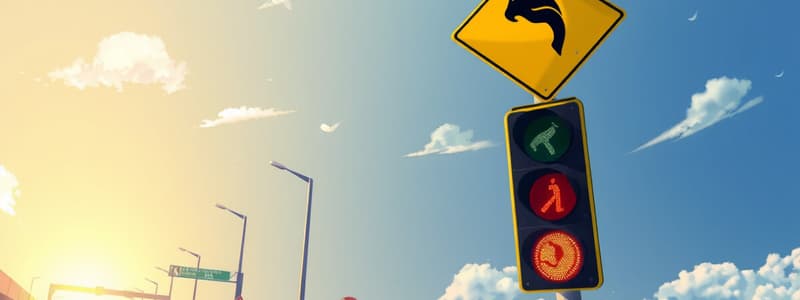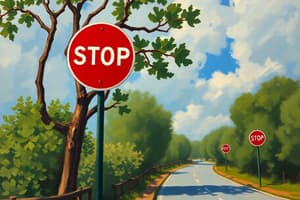Podcast
Questions and Answers
What does a rectangle (horizontal) sign represent?
What does a rectangle (horizontal) sign represent?
- Stop signs
- Regulatory signs
- Guide signs (correct)
- Warning signs
What type of sign is indicated by a diamond shape?
What type of sign is indicated by a diamond shape?
- Warning signs (correct)
- Guide signs
- Stop signs
- Regulatory signs
What should you do at a stop sign?
What should you do at a stop sign?
Come to a full stop at the intersection.
What does a yield sign indicate?
What does a yield sign indicate?
What does a do not enter sign signify?
What does a do not enter sign signify?
What should you do when you see a wrong way sign?
What should you do when you see a wrong way sign?
What does a 5-sided sign indicate?
What does a 5-sided sign indicate?
A _____-shaped sign warns you of specific road conditions.
A _____-shaped sign warns you of specific road conditions.
Warning signs are only yellow.
Warning signs are only yellow.
What does a railroad crossing sign warn drivers about?
What does a railroad crossing sign warn drivers about?
What should you do when approaching a traffic signal ahead sign?
What should you do when approaching a traffic signal ahead sign?
What does Merging Traffic mean?
What does Merging Traffic mean?
What does a narrow bridge sign indicate?
What does a narrow bridge sign indicate?
A double solid white line allows crossing.
A double solid white line allows crossing.
Flashcards are hidden until you start studying
Study Notes
Signs and Their Shapes
- Vertical rectangles indicate regulatory signs; horizontal rectangles serve as guide signs.
- Warning signs are represented by diamond shapes; octagons signify stop signs.
- Pennant shapes denote no passing zones; pentagons indicate school zones.
- Trapezoids signify recreation areas and national park forest routes; triangles are yield signs.
- Crossbuck signs signify railroad crossings; round signs are for railroad crossings and emergency evacuation routes.
Function of Traffic Signs
- Traffic signs communicate rules, hazards, location information, navigational guidance, and service availability.
Specific Traffic Signs
- Stop sign: Requires a full stop at intersections; vehicles must yield to pedestrians and other vehicles.
- Yield sign: Drivers must slow down and yield to crossing vehicles or pedestrians; stopping is often required.
- Do not enter sign: Prohibits entry into restricted areas.
- Wrong way sign: Informs drivers they are traveling in the wrong direction; instructs to stop and turn around safely.
No Signs and Warning Signs
- "No" signs feature a red circle with a line through them, indicating prohibitions, such as "no U-turn."
- Yellow-green signs alert drivers to pedestrian-related hazards, school zones, and playgrounds.
Road Condition and Turn Indicators
- Warning signs draw attention to unexpected conditions, advising caution and potential speed reduction.
- Curvature: A turn involves speeds less than 35 mph, while curves are for speeds greater than 35 mph.
Traffic Control and Merging
- Merging traffic signs indicate the merging of two lanes into one.
- Lane reduction signs necessitate merging for left or right lane reductions.
Pavement Conditions
- Slippery conditions may occur when roads are damp, frozen, or wet; watch for signs indicating changes in pavement types.
Railroad and Warning Signs
- Railroad crossing signs signal upcoming crossings; drivers must be alert and prepared to stop if necessary.
- Advisory speed plates suggest speed but are not enforceable, while white speed limit signs are legally binding.
Lane and Road Markings
- Yellow lines regulate passing; solid lines prohibit crossing, while dashed lines allow it.
- White longitudinal lines mark lane edges; dashed lines signify lanes that can be crossed and solid lines indicate where crossing is discouraged.
Curbs and Parking Restrictions
- Curbs feature specific color codes: red for prohibitive parking, blue for handicap access, yellow for temporary stopping/delivery, green for limited-duration parking, and white for drop-offs.
Miscellaneous Signs
- Double solid white lines indicate no crossing between two lanes in the same direction.
- Restricted lane signs denote lanes reserved for specific vehicles such as buses or car-pools.
Intersections and Traffic Control
- Proper signaling is vital entering designated turn lanes; it communicates intention to other drivers.
ABS Misconception
- Anti-lock Braking System (ABS) does not increase stopping distance; it enhances control and braking efficacy during emergency stops.
Studying That Suits You
Use AI to generate personalized quizzes and flashcards to suit your learning preferences.



